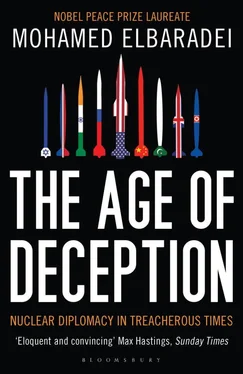During the meeting, Iran dramatically announced that they did not want France to be party to the agreement. As their reason, they cited France’s failure to deliver the fifty tons of uranium Iran had bought before the 1979 Revolution—exactly the point I had asked Salehi not to raise. I suspected, though, that the undelivered uranium was not the real reason for Iran’s antipathy toward the French, recalling Ahmadinejad’s complaints about Sarkozy being “impolite.” Sarkozy always found ways to insult Iran. In late August, for example, he had reportedly said, “It is the same leaders in Iran who say that the nuclear program is peaceful and that the elections were honest. Who can believe them?” [24] James Mackenzie, “France’s Sarkozy Raises Iran Sanction Threat,” Reuters, August 27, 2009.
The Iranians were using this opportunity to get back at the French, even though Sarkozy had offered Obama his support for the deal. Indeed, France was one of the only countries with the technology to manufacture Iran’s research reactor fuel. A call to Salehi was in order. “I think you have made your point vis-à-vis the French,” I said. “You will need them in the future for technology—both for power and research reactors.” I suggested that I could keep the French in the agreement as my own proposal.
The Iranians could live with that, Salehi said, and asked me to have the French send their ambassador in Tehran to see him the next day. In a sidebar meeting with the French delegation, I explained how we had worked to keep them in the deal. “You have to ask your people in Paris to control the rhetoric,” I said. “You cannot publicly accuse people of lying and then expect them to trust you as a partner.” Our next hurdle arose when the Iranians moved to bargain over the modalities for shipping the uranium abroad. The understanding in the P-5+1 meeting in Geneva had been that all twelve hundred kilograms of LEU would be removed in one go. Iran now insisted that they first had to receive the fuel, manufactured from some other source of LEU, and only then would they release their own stockpile of enriched uranium, in two batches. This, they said, was because of the stated lack of trust and their past experience.
As a way out, I suggested that the Agency could take custody of the material from the time it left Iran until it was returned in the form of fuel, thus giving Iran the guarantee it needed. In any case, Iran’s risk would be fairly low: its enrichment capability remained intact. As I told Soltanieh and his colleagues, the timing and amount of LEU to be delivered was, in my view, a red line for the Americans and other Western countries.
We were at an impasse. I called on Salehi, who, to my surprise, said they would deliver the entire twelve hundred kilograms if the United States were their counterpart in the agreement, instead of Russia or France. It was a brilliant stroke. By bypassing the third-party countries, the Iranians would open the door to direct bilateral dialogue with the Americans. This is what Ahmadinejad had told me they wanted all along. It would also send a message of trust and confidence in both directions, from Tehran to Washington and back again.
On receiving Salehi’s message, the Americans were flabbergasted. Poneman and his team scrambled to call Washington for guidance at around four o’clock in the morning, D.C. time. They finally responded with a counteroffer. The United States would not be a partner in the agreement, but they would issue a political statement of support and would commit to helping Iran upgrade the safety of their old research reactor. This was a giant step forward. I suggested that the commitment from Washington be annexed to the fuel agreement and signed by the Americans. They agreed on the spot.
Poneman got authorization to see Soltanieh in a bilateral talk. Soltanieh said he could meet Poneman only if I were present. I took them both into my office. Poneman expressed, on behalf of the U.S. government, their goodwill toward the Iranian people. The conclusion of this fuel agreement, he said, could open the way to a broad range of cooperation between the two countries, including providing Iran with new research reactors, which Iran was keen to have. The meeting was cordial and friendly. Soltanieh took careful notes to report to Tehran.
We were balanced on a high wire, somewhere between a momentous breakthrough and failure. Late that night, I called Salehi, promising to email him a copy of the U.S. statement. I asked him to impress on Ahmadinejad that this deal would empower both sides to change completely the terms of their dealings. I explained that according to Poneman it was too difficult for the Americans to accept bringing the Iranian material to the United States for further enrichment and fabrication. There would be too many hoops to jump through because of sanctions and domestic restrictions vis-à-vis Iran.
We spoke again early the next morning. It was now October 21, the final day of the fuel proposal meeting. Salehi was sitting with Ahmadinejad, who had another idea. He suggested that the Americans be the counterpart to the agreement but with the work subcontracted to the Russians and the French. The LEU would not need to go to the United States at all. Salehi added that he needed the Iranian team to come back to Tehran, so that he would not seem to be the only one advising the Iranian president. They would need a couple of days, he said, to provide a response.
I reconvened the meeting. I presented the proposal in the form discussed with Poneman and Soltanieh at the previous day’s meeting: Iran would ship out the full twelve hundred kilograms of LEU, and the Agency would take custody of it, with the United States giving a statement of political support. I told the participants that they had until Friday, October 23, to give their final approval. I urged them to approve it, noting the doors that would be opened by the agreement. I was of course addressing primarily Iran; the other three participants, the United States, Russia, and France, were already on board.
With the meeting concluded, I made a short, upbeat statement to the press. The U.S. delegation dropped by to express Washington’s appreciation. Obama called later in the day to thank me personally. “If this agreement is approved,” he said, “it will change the dynamics here for me.” It would give him the space needed for negotiation with Iran on many fronts. More than once, for so many reasons, I felt the need to pinch myself.
The celebrations were premature. In Tehran, attitudes within the political establishment had been hardening since the P-5+1 Geneva meeting at the beginning of the month. Critics on all sides, including the liberal faction that had recently lost the presidential election, were accusing Ahmadinejad of selling the store. Ali Larijani, who had seen his efforts to achieve a de facto suspension vetoed by Ahmadinejad, was now chairman of the Majlis. It was political payback time. He had joined the ranks of those criticizing the fuel proposal as an “insult to the nation.” Why, they asked, should Iran not be able to buy its fuel on the market like any other country?
Ray Takeyh, an Iran expert on the U.S. Council on Foreign Relations, summarized the situation eloquently: “There’s been a breakdown in the country’s foreign policy machinery. Iran doesn’t have a foreign policy right now. It has domestic politics, and its foreign policies are just a sporadic expression of that. It’s not sinister; it’s not duplicitous; it’s just incompetent.” [25] Doyle McManus, “Talking with Iran—and Sending a Message,” Los Angeles Times , November 1, 2009.
I had just over a month left at the IAEA. I was in daily contact with Poneman in Washington and Salehi in Tehran, trying to hammer out a deal. Salehi kept floating and then retracting a number of add-on proposals to sweeten the arrangement; he was consumed with trying to find a way to sell the deal in Tehran. Eventually he came back with an answer: Ahmadinejad could agree only if the LEU remained at home until the Iranians received the research reactor fuel. They proposed storing the LEU on the island of Kish in the Persian Gulf, under IAEA custody and control. Iran would be ready to swap the material as soon as the fuel was delivered.
Читать дальше












